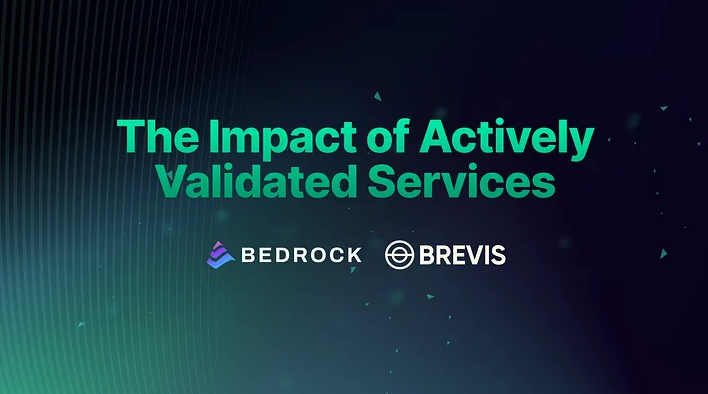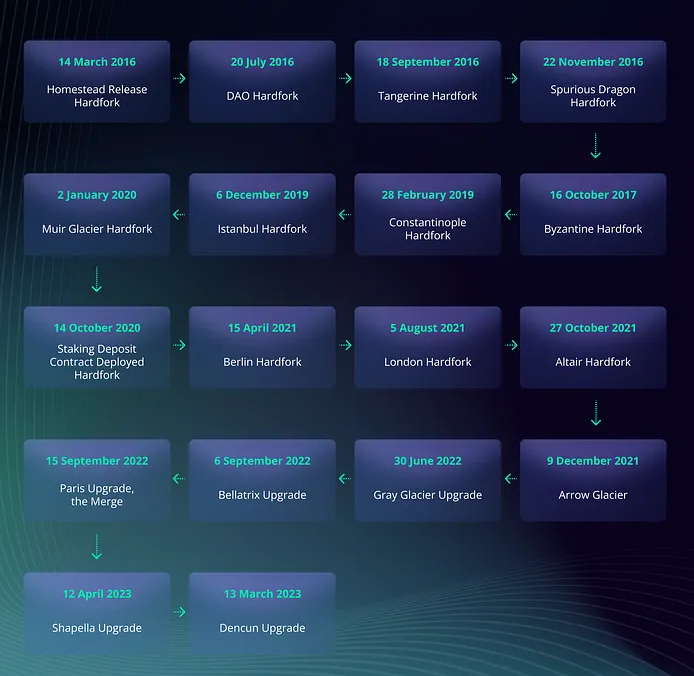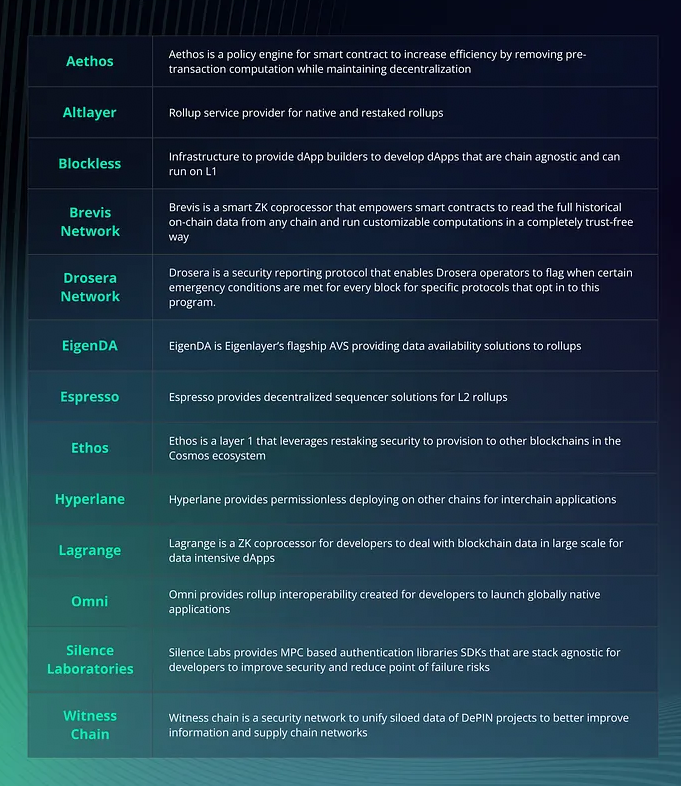EigenLayer is building a new Ethereum ecosystem based on Restaking for rapid development.
Author: Bedrock
Translation: Blockchain in Plain Language

In the past two to three years, the transition of Ethereum from Proof of Work (PoW) to Proof of Stake (PoS) has been highly anticipated, bringing some good news to investors in the crypto winter. Even before these PoS system upgrades, the Ethereum Foundation and the community have continuously built and improved the network through multiple upgrades and hard forks to achieve today's accomplishments.

Ethereum's past hard forks and network upgrade roadmap
The transition of the Ethereum network to the Proof of Stake (PoS) model marks a revolutionary advancement in blockchain technology, emphasizing energy efficiency and maintaining high efficiency in decentralization and network security, reaching up to 99.95%, according to the Ethereum Foundation. By allowing holders willing to "stake" a certain amount of ETH to verify transactions, PoS not only strengthens network security but also enhances scalability. Since then, we have witnessed the rapid rise of the Restaking mechanism introduced by EigenLayer, which has climbed to the forefront of Total Value Locked (TVL) rankings, reaching an astonishing $15 billion at the time of writing. This process allows ETH stakers to essentially "reutilize" their assets by verifying Ethereum and other trusted networks, but these networks must be compatible with EigenLayer, known as Active Verification Services (AVS).
1. About AVS
Currently, EigenLayer's ecosystem page lists 13 valid Active Verification Services (AVS). For existing DeFi dApps to become valid AVS and accept Restaking ETH through EigenLayer, they need to go through a series of strict processes. However, once successful, developers can leverage Ethereum's security layer and focus their efforts on developing other parts of the product.
Unlike traditional staking or liquid staking, Restaking or Liquid Staking of ETH through EigenLayer not only benefits the protection of the Ethereum blockchain but also benefits the listed AVS (Active Verification Services). Since the M2 upgrade, AVS operators responsible for network security can choose which AVS to verify. Additionally, Restakers can also choose which operator to delegate their ETH to. This flexibility allows Restaking ETH to meet the personalized needs of participants while ensuring network security.
2. AVS Ecosystem
Before we continue, let's clarify some key terms that are often confusing to those unfamiliar with EigenLayer.
Active Verification Services (AVS): As mentioned earlier, these are dApps that obtain Restaking ETH through the onboarding process of EigenLayer.
AVS Operators: These individuals or organizations operate punitive nodes to support AVS and receive predetermined rewards.
Validators: These nodes may be penalized and form the infrastructure supporting EigenLayer's re-staking operation.
Essentially, the validators operated by AVS operators contribute to the benefits of AVS on EigenLayer. These three interconnected components form an ecosystem that allows trusted networks to benefit from Ethereum's robust security layer. As the largest PoS chain, Ethereum is almost able to withstand a 51% attack, as it would cost $34 billion.
In their whitepaper, EigenLayer aims to address four pain points in establishing a trusted network:
1) Bootstrapping (raising capital)
2) Value leakage
3) Capital costs
4) Low trust (dApp security)
Bootstrapping—trusted networks running on some verification systems require participants to set up nodes to verify the network and commit network tokens as stakes. For developers, bootstrapping becomes an issue as they need to attract operators to set up nodes, purchase tokens, and stake, consuming time and effort that could be used for product development.
Value leakage—In the setup of each trusted network, users need to pay transaction fees for using these networks in addition to Ethereum.
Capital costs—Validators weigh the opportunity cost of verifying a new network, which has large price fluctuations and unknown returns, compared to Ethereum, which has lower returns but relatively stable prices. New networks must provide high enough returns to attract these validators, sometimes leading to expenses exceeding data storage and network costs.
Low trust—dApps rely on building their trusted networks and oracle networks. These layers can become attack points, and when these networks require lower stakes to secure middleware and trust pools, the risk of attack increases. Imagine a dApp built on Ethereum that relies on an oracle network with a total value of $1 million. An attacker only needs $510,000 to launch a 51% attack on the oracle network, compared to the $34 billion required to attack Ethereum.
For the Ethereum ecosystem, it benefits from more resilient and secure dApps, further enriching its already vibrant ecosystem. In fact, Restaking has introduced a new wave of DeFi frenzy called "LRTfi." These are various protocols built on EigenLayer technology, further benefiting Ethereum users. For example, ETH liquidity restaking, such as the service provided by Bedrock, allows users to restake ETH without losing liquidity. From here, rewards and further earnings for the entire ecosystem can be generated through protocols like Pendle.
As AVS continues to be built on Ethereum through EigenLayer, the additional value brought by these AVS is introduced and aggregated into the foundational layer of the chain, eliminating the need for operators and users to choose between networks and bringing more value to stakers.
3. Concept and Operation of AVS
AVS candidates include modules that cannot be deployed directly on Ethereum, such as oracle networks, guardian networks, data availability layers, and cross-chain bridges. To leverage Ethereum's security, EigenLayer provides infrastructure for these modules so that Ethereum node operators can adopt these modules. AVS needs to list software requirements and deploy software for potential AVS operators to download, and a smart contract needs to be deployed, detailing penalty terms and payment structures.
AVS operators are validators running Ethereum nodes who choose to support AVS through EigenLayer. They enable native Ethereum staking by changing the withdrawal credentials to EigenLayer's smart contract.
AVS can design their own consensus mechanisms (such as PoS, PPoS, DPoS), but can rely on these AVS operators to run nodes and ensure the security of their trusted networks. This means that trusted networks can benefit from security, while project teams can focus more resources on developing their intended features. Additionally, this reduces the value leakage of the Ethereum network, as stakers and validators no longer need to choose between Ethereum and other projects. In return, stakers and validators receive more earnings from the ETH they stake, as AVS rewards participants in securing their networks.
4. Security and Risks Behind AVS
The discussion around EigenLayer's TVL of up to $15 billion has raised concerns, with some questioning the potential risks of a significant decrease in TVL due to overgrowth. Some have proposed solutions such as increasing security budget requirements, but many believe the best remedy is to increase utility or introduce more AVS. However, as this is an emerging innovation, it is difficult to determine if this will become a problem and what possible solutions might be.
The Proposal-builder-separation design aims to prevent centralization risks caused by validators staking, but the ability of AVS operators to provide services to as many AVS as possible has surpassed this solution. Increasing the combination of AVS services can increase the earnings of validators, which are then paid to delegators. However, providing operational services is not as simple as "buying and selling" on Robinhood.
Operators need to weigh the risks and rewards of running AVS, which requires investment of funds and resources. Operators need to promote their services and attract delegators, which also requires investment of funds and resources. Operators must manage the entire operation of AVS nodes, which also requires resources and capital. Operators with stronger teams and the ability to expand will be able to handle more services, thereby earning more and attracting more delegators. Additionally, delegators are more likely to choose operators that appear more mature and financially robust for delegation. This leads to staking being concentrated in the hands of a few validators, creating centralization risks.
Operators need to quantify and consider the security of the provided AVS to understand the risk-adjusted return. Considered risks include the maximum penalty amount that AVS may face, liquidity risk of AVSToken, marginal costs, and the risk of providing more services to other AVS. Some suggest applying the principles of the Sharpe ratio.
The Enzo protocol suggests identifying the maximum possible loss for a specific AVS, for example, the maximum loss for providing services to that AVS is 7% due to downtime penalties and double-signing penalties. The sum of all maximum losses provides a concept of the staking risk faced by providing security for multiple AVS.
On the other hand, the total return of this AVS combination minus the infrastructure costs of running operations can be considered excess return. Excess return minus the risk of maximum loss can roughly estimate the risk-adjusted return specific to the penalty risk.
This example illustrates the risks that need to be considered when taking on more services as an AVS operator.
As a leading blockchain infrastructure provider, RockX is committed to transparency and decentralization. This commitment extends to being an AVS operator, as we are fully committed to the security of being an AVS operator and take pride in being responsible and transparent to users.
5. The Future of AVS
In EigenLayer's mainnet release announcement, they discussed future developments and the gradual rollout plan for the mainnet, mentioning the construction of a tool to facilitate the smooth onboarding and integration of AVS.
With the launch of EigenDA, EigenLayer plans to lay the foundation for its concept, as operators will register and begin selecting to join EigenDA. EigenLayer mentioned that many new AVS are in the works and ready to be launched. This will mean better innovation in the field, as teams can reduce their focus on launching their protocols and concentrate on providing innovative solutions. As EigenLayer continues to evolve, more features will be introduced to make it easier for AVS to onboard and improve the ecosystem.
6. Solutions Behind AVS

These AVS bring numerous innovative solutions and middleware for developers, aimed at bringing more applications to the field. EigenLayer provides infrastructure that addresses the four major issues faced by these trusted networks. These trusted networks can now more freely focus on their solutions, such as decentralized sorters, coprocessors, or security reports. Overall, these AVS provide middleware solutions for dApps, enabling them to develop more secure, efficient, interoperable, and decentralized products.
As the official AVS operator, RockX proudly supports EigenDA and Brevis coChain AVS. Just as becoming an AVS operator in the early stages of EigenLayer's development requires extensive preparation. EigenLayer's documentation page lists all hardware and software requirements. In short, operators must meet at least the delegation and system requirements and comply with the Service Level Agreement (SLA) for the protocol.
A simpler approach is to delegate ETH to existing AVS operators, such as RockX. RockX has over 13,300 validators and nearly 426,000 staked ETH, making it a leader in the local restaking community. Additionally, RockX has an impressive record of zero penalties, providing greater peace of mind when delegating to its validators. Our previous blog on the EigenLayer M2 upgrade may provide a clearer understanding of AVS operators and the specific operations of EigenLayer.
1) Brevis coChain AVS
In April 2024, Brevis announced the launch of Brevis coChain AVS on the mainnet, with 29 operators choosing to join. RockX is proud to be one of these 29 operators.
Brevis is an intelligent ZK coprocessor that allows smart contracts to read on-chain data from any chain's complete history and run customizable computations in a fully trustless manner. Brevis coChain introduces a new "proposal-challenge" ZK coprocessor model. In this model, proposers can generate and submit coprocessing results on-chain without completing the entire ZK proof computation. Brevis coChain is a PoS network that accepts coprocessing requests from smart contracts and optimistically generates coprocessing results through PoS consensus. These results generated by PoS are submitted to the blockchain as "proposals" and can be "challenged" through ZK proofs. If no challenge is initiated, the results can be used directly by dApps without incurring the cost of generating ZK proofs. Brevis coChain AVS has been launched on the mainnet in collaboration with EigenLayer, introducing a new ZK coprocessor architecture that combines the advantages of cryptographic economic security and zero-knowledge proofs into one model.
As a node operator for Brevis coChain AVS, RockX will engage in coprocessing with other operators, leveraging EigenLayer's restaking infrastructure to generate optimistic results for requests from smart contracts and dApps. The collaboration between Brevis coChain and RockX fully utilizes the security and decentralization of Ethereum while significantly reducing costs, reducing latency, and improving scalability.
"We are excited to collaborate with Brevis to bring more innovation to the blockchain world. This collaboration will make the Ethereum ecosystem stronger, more efficient, and user-friendly. By combining Brevis's cutting-edge technology with RockX's reliable infrastructure, we can help developers create better, more secure applications. This collaboration is a significant step forward for us, and we look forward to seeing its positive impact on the broader blockchain community." said Chen Zhuling, CEO of RockX.
2) RockX Local Restaking Solution
As one of the top ten operators in Total Value Locked (TVL), RockX has put in a lot of effort in the Restaking field. As an experienced staking service provider, they currently offer staking solutions for over 20 PoS blockchains. They have accumulated rich experience in the crypto industry since 2017 and have a professional team that investors can confidently delegate their assets to. Additionally, well-known crypto institutions like Amber Group are also long-time clients of RockX. Coupled with their advantage of zero penalties, you will get a reliable Restaking solution.
In a post about April, they revealed that they have recently surpassed over $11 billion in staked ETH and are further expanding their staking solutions, including Bitcoin.
7. Conclusion
AVS can be any trust network that needs protection. Many of them include middleware utilized by dApps for functionality and building user-friendly products. With Eigenlayer introducing a way to address a major headache for these trust networks, teams will be able to focus more on providing innovative and secure solutions.
In shaping the future of permissionless innovation, and with the emergence of AVS solutions (besides EigenDA), RockX fully supports this initiative. As an AVS operator and a leading multi-asset Restaking protocol, we are excited about the opportunities for Restaking/Staking utility and remain committed to decentralization and security, continuously supporting the AVS community.
Original article link: https://www.hellobtc.com/kp/du/06/5220.html
Source: https://medium.com/@bedrock_defi/the-role-and-impact-of-actively-validated-services-avss-on-ethereum-2b68fbaf5292
免责声明:本文章仅代表作者个人观点,不代表本平台的立场和观点。本文章仅供信息分享,不构成对任何人的任何投资建议。用户与作者之间的任何争议,与本平台无关。如网页中刊载的文章或图片涉及侵权,请提供相关的权利证明和身份证明发送邮件到support@aicoin.com,本平台相关工作人员将会进行核查。




